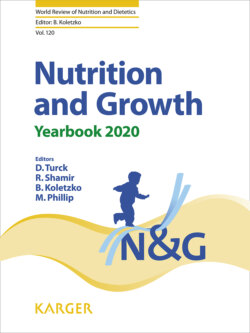Читать книгу Nutrition and Growth - Группа авторов - Страница 47
На сайте Литреса книга снята с продажи.
References
Оглавление1Lobstein T, Jackson-Leach R, Moodie ML, et al: Child and adolescent obesity: Part of a bigger picture. Lancet 2015;385:2510–2520.
2Baird J, Fisher D, Lucas P, et al: Being big or growing fast: systematic review of size and growth in infancy and later obesity. BMJ 2005;331:929.
3Acharya K, Feese M, Franklin F, et al: Body mass index and dietary intake among Head Start children and caregivers. J Am Diet Assoc 2011;111:1314– 1321.
4Stang J, Loth KA: Parenting style and child feeding practices: Potential mitigating factors in the etiology of childhood obesity. J Am Diet Assoc 2011;111: 1301–1305.
5Dhana K, Zong G, Yuan C, et al: Lifestyle of women before pregnancy and the risk of offspring obesity during childhood through early adulthood. Int J Obes (Lond) 2018;42:1275–1284.
6Carolan-Olah M, Duarte-Gardea M, Lechuga J: A critical review: Early life nutrition and prenatal programming for adult disease. J Clin Nurs 2015;24: 3716–3729.
7Shim JE, Kim J, Mathai RA: Associations of infant feeding practices and picky eating behaviors of preschool children. J Am Diet Assoc 2011;111:1363– 1368.
8Friedman G, Goldberg SJ: Concurrent and subsequent serum cholesterol of breast- and formula-fed infants. Am J Clin Nutr 1975;28:42–45.
9Wong WW, Hachey DL, Insull W, et al: Effect of dietary cholesterol on cholesterol synthesis in breastfed and formula-fed infants. J Lipid Res 1993;34: 1403–1411.
10Wu J, Gouveia-Figueira S, Domellöf M, et al: Oxylipins, endocannabinoids, and related compounds in human milk: Levels and effects of storage conditions. Prostaglandins Other Lipid Mediat 2016;122:28–36.
11Witkamp RF: The role of fatty acids and their endocannabinoid-like derivatives in the molecular regulation of appetite. Mol Aspects Med 2018;64:45–67.
12Fields DA, Schneider CR, Pavela G: A narrative review of the associations between six bioactive components in breast milk and infant adiposity. Obesity (Silver Spring) 2016;24:1213–1221.
13Barker DJ: Fetal programming of coronary heart disease. Trends Endocrinol Metab 2002;13:364–368.
14Mennella JA, Inamdar L, Pressman N, et al: Type of infant formula increases early weight gain and impacts energy balance: A randomized controlled trial. Am J Clin Nutr 2018;108:1015–1025.
15Fernández-Alvira JM, Bammann K, Eiben G, et al: Prospective associations between dietary patterns and body composition changes in European children: The IDEFICS study. Public Health Nutr 2017; 20:3257–3265.
16Evans CE, Christian MS, Cleghorn CL, et al: Systematic review and meta-analysis of school-based interventions to improve daily fruit and vegetable intake in children aged 5–12 y. Am J Clin Nutr 2012;96: 889–901.
17Rupérez AI, Mesana MI, Moreno LA: Dietary sugars, metabolic effects and child health. Curr Opin Clin Nutr Metab Care 2019;22:206–216.
18De Henauw S, Verbestel V, Mårild S, et al; IDEFICS Consortium. The IDEFICS community-oriented intervention programme: A new model for childhood obesity prevention in Europe? Int J Obes (Lond) 2011;35(suppl 1):S16–S23.
19Mattes RD, Popkin BM: Nonnutritive sweetener consumption in humans: Effects on appetite and food intake and their putative mechanisms. Am J Clin Nutr 2009;89:1–14.
20de Koning L, Malik VS, Rimm EB, et al: Sugar-sweetened and artificially sweetened beverage consumption and risk of type 2 diabetes in men. Am J Clin Nutr 2011;93:1321–1327.
21Sylvetsky AC, Jin Y, Mathieu K, et al: Low-calorie sweeteners: disturbing the energy balance equation in adolescents? Obesity (Silver Spring) 2017; 25: 2049–2054.
22Rother KI, Conway EM, Sylvetsky AC: How non-nutritive sweeteners influence hormones and health. Trends Endocrinol Metab 2018;29:455–467.
23Young J, Conway EM, Rother KI, et al: Low-calorie sweetener use, weight, and metabolic health among children: a mini-review. Pediatr Obes 2019; 14: e12521.
24Dekker MJ, Su Q, Baker C, et al: Fructose: A highly lipogenic nutrient implicated in insulin resistance, hepatic steatosis, and the metabolic syndrome. Am J Physiol Endocrinol Metab 2010;299:E685–E694.
25Lustig RH: Fructose: it’s “alcohol without the buzz.” Adv Nutr 2013;4:226–235.
26Kanuri G, Ladurner R, Skibovskaya J, et al: Expression of toll-like receptors 1–5 but not tlr 6–10 is elevated in livers of patients with non-alcoholic fatty liver disease. Liver Int 2015;35:562–568.
27Calder PC: Omega-3 polyunsaturated fatty acids and inflammatory processes: nutrition or pharmacology? Br J Clin Pharmacol 2012;75:645–662.
28López-Alarcón M, Martínez-Coronado A, Velarde-Castro O, et al: Supplementation of n3 long-chain polyunsaturated fatty acid synergistically decreases insulin resistance with weight loss of obese prepubertal and pubertal children. Arch Med Res 2011;42: 502–508.
29Michail S, Lin M, Frey MR, et al: Altered gut microbial energy and metabolism in children with nonalcoholic fatty liver disease. FEMS Microbiol. Ecol 2015;91:1–9.
30Jahnel J, Zöhrer E, Alisi A, et al: Serum bile acid levels in children with nonalcoholic fatty liver disease. J Pediatr Gastroenterol Nutr 2015;61:85–90.
Shlomit Shalitin
The Jesse Z. and Sara Lea Shafer Institute of Endocrinology and Diabetes
National Center for Childhood Diabetes Schneider Children’s Medical Center of Israel
14 Kaplan Street
Petach Tikva 4920235 (Israel)
E-Mail shalitin@netvision.net.il
